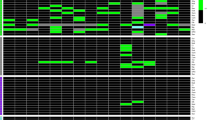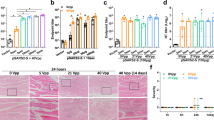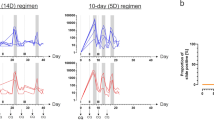Abstract
In animals, effective immune responses against malignancies and against several infectious pathogens, including malaria, are mediated by T cells. Here we show that a heterologous prime-boost vaccination regime of DNA either intramuscularly or epidermally, followed by intradermal recombinant modified vaccinia virus Ankara (MVA), induces high frequencies of interferon (IFN)-γ-secreting, antigen-specific T-cell responses in humans to a pre-erythrocytic malaria antigen, thrombospondin-related adhesion protein (TRAP). These responses are five- to tenfold higher than the T-cell responses induced by the DNA vaccine or recombinant MVA vaccine alone, and produce partial protection manifest as delayed parasitemia after sporozoite challenge with a different strain of Plasmodium falciparum. Such heterologous prime-boost immunization approaches may provide a basis for preventative and therapeutic vaccination in humans.
This is a preview of subscription content, access via your institution
Access options
Subscribe to this journal
Receive 12 print issues and online access
$259.00 per year
only $21.58 per issue
Buy this article
- Purchase on SpringerLink
- Instant access to full article PDF
Prices may be subject to local taxes which are calculated during checkout



Similar content being viewed by others
References
Harty, J.T., Tvinnereim, A.R. & White, D.W. CD8+ T cell effector mechanisms in resistance to infection. Annu. Rev. Immunol. 18, 275–308 (2000).
Kaech, S.M., Wherry, E.J. & Ahmed, R. Effector and memory T-cell differentiation: implications for vaccine development. Nat. Rev. Immunol. 2, 251–262 (2002).
Parker, D.C. T cell-dependent B cell activation. Annu. Rev. Immunol. 11, 331–360 (1993).
Doolan, D.L. & Hoffman S.L. The complexity of protective immunity against liver-stage malaria. J. Immunol. 165, 1453–1462 (2000).
Guidotti, L.G. et al. Intracellular inactivation of the hepatitis B virus by cytotoxic T lymphocytes. Immunity 4, 25–36 (1996).
Villinger, F. et al. Adoptive transfer of simian immunodeficiency virus (SIV) naive autologous CD4+ cells to macaques chronically infected with SIV is sufficient to induce long-term nonprogressor status. Blood 99, 590–599 (2002).
Winter, H., Hu, H.M., Urba, W.J. & Fox, B.A. Tumor regression after adoptive transfer of effector T cells is independent of perforin or Fas ligand (APO-1L/CD95L). J. Immunol. 163, 4462–4472 (1999).
Becker, C. et al. Adoptive tumor therapy with T lymphocytes enriched through an IFN-γ capture assay. Nat. Med. 7, 1159–1162 (2001)
Seki, N. et al. Tumor-specific CTL kill murine renal cancer cells using both perforin and Fas ligand-mediated lysis in vitro, but cause tumor regression in vivo in the absence of perforin. J. Immunol. 168, 3484–3492 (2002).
Zwaveling, S. et al. Established human papillomavirus type 16-expressing tumors are effectively eradicated following vaccination with long peptides. J. Immunol. 169, 350–358 (2002).
Bertoletti, A. et al. HLA class I restricted human cytotoxic T cells recognise endogenously synthesised hepatitis B virus nucleocapsid antigen. Proc. Natl. Acad. Sci. USA 88, 10445–10449 (1991).
Boni, C. et al. Lamivudine treatment can restore T cell responsiveness in chronic hepatitis B. J. Clin. Invest. 102, 968–975 (1998).
Wang, R. et al. Induction of antigen-specific cytotoxic T lymphocytes in humans by a malaria DNA vaccine. Science 282, 476–480 (1998).
Wang, R. et al. Induction of CD4+ T cell-dependent CD8+ type 1 responses in humans by a malaria DNA vaccine. Proc. Natl. Acad. Sci. USA 98, 10817–10822 (2001).
Roy, M.J. et al. Induction of antigen-specific CD8+ T cells, T helper cells, and protective levels of antibody in humans by particle-mediated administration of a hepatitis B virus DNA vaccine. Vaccine 19, 764–778 (2000).
Gupta, K. et al. Safety and immunogenicity of a high-titered canarypox vaccine in combination with rgp120 in a diverse population of HIV-1-uninfected adults: AIDS Vaccine Evaluation Group Protocol 022A. J. Acquir. Immune Defic. Syndr. 29, 254–261 (2002).
Lalvani, A. et al. Potent induction of focused Th1-type cellular and humoral immune responses by RTS/S/SBAS2, a recombinant Plasmodium falciparum malaria vaccine. J. Infect. Dis. 180, 1656–1664 (1999).
Schneider, J. et al. Enhanced immunogenicity for CD8+ T cell induction and complete protective efficacy of malaria DNA vaccination by boosting with modified vaccinia virus Ankara. Nat. Med. 4, 397–402 (1998).
Hanke, T. et al. Enhancement of MHC class I-restricted peptide-specific T cell induction by a DNA prime/MVA boost vaccination regime. Vaccine 16, 439–445 (1998).
McShane, H., Brookes, R., Gilbert, S.C. & Hill, A.V. Enhanced immunogenicity of CD4+ T-cell responses and protective efficacy of a DNA-modified vaccinia virus Ankara prime-boost vaccination regimen for murine tuberculosis. Infect. Immun. 69, 681–686 (2001).
Schneider, J. et al. Induction of CD8+ T cells using heterologous prime-boost immunisation strategies. Immunol. Rev. 170, 29–38 (1999).
Gilbert, S.C. et al. Enhanced CD8 T cell immunogenicity and protective efficacy in a mouse malaria model using a recombinant adenoviral vaccine in heterologous prime-boost immunisation regimes. Vaccine 20, 1039–1045 (2002).
Gilbert, S.C. et al. A protein particle vaccine containing multiple malaria epitopes. Nat. Biotechnol. 15, 1280–1284 (1997).
Sullivan, N.J., Sanchez, A., Rollin, P.E., Yang, Z.Y. & Nabel, G.J. Development of a preventive vaccine for Ebola virus infection in primates. Nature 408, 605–609 (2000).
Amara, R.R. et al. Control of a mucosal challenge and prevention of AIDS by a multiprotein DNA/MVA vaccine. Science 292, 69–74 (2001).
Marshall, E. Renewed assault on an old and deadly foe. Science 290, 428–430 (2000).
Hill, A.V.S. et al. Common West African HLA antigens are associated with protection from severe malaria. Nature 352, 595–600 (1991).
Herrington, D. et al. Successful immunization of humans with irradiated malaria sporozoites: humoral and cellular responses of the protected individuals. Am. J. Trop. Med. Hyg. 45, 539–547 (1991).
Hoffman, S.L. et al. Sporozoite vaccine induces genetically restricted T cell elimination of malaria from hepatocytes. Science 244, 1078–1081 (1989).
Robson, K.J. et al. A highly conserved amino-acid sequence in thrombospondin, properdin and in proteins from sporozoites and blood stages of a human malaria parasite. Nature 335, 79–82 (1988).
Moorthy, V.S. et al. Safety of DNA and modified vaccinia virus Ankara vaccines against liver-stage P. falciparum malaria in non-immune volunteers. Vaccine 21, 2004–2011 (2003).
Chulay, J.D. et al. Malaria transmitted to humans by mosquitoes infected from cultured Plasmodium falciparum. Am. J. Trop. Med. Hyg. 35, 66–68 (1986).
Ponnudurai, T., Meuwissen, J.H.E.T., Leeuwenberg, A.D.E.M., Verhave, J.P. & Lensen, A.H.W. The production of mature gametocytes of Plasmodium falciparum in continuous cultures of different isolates infective to mosquitoes. Trans. R. Soc. Trop. Med. Hyg. 76, 242–250 (1982).
Simpson, J.A., Aarons, L., Collins, W.E., Jeffery, G.M. & White, N.J. Population dynamics of untreated Plasmodium falciparum malaria within the adult human host during the expansion phase of the infection. Parasitology 124, 247–263 (2002).
Davis J.R. et al. Estimate of anti-Plasmodium falciparum sporozoite activity in humans vaccinated with synthetic circumsporozoite protein (NANP)3. Trans. R. Soc. Trop. Med. Hyg. 83, 748–750 (1989).
Schneider, J. et al. A prime-boost immunisation regimen using DNA followed by recombinant modified vaccinia virus Ankara induces strong cellular immune responses against the Plasmodium falciparum TRAP antigen in chimpanzees. Vaccine 19, 4595–4602 (2001).
Robson, K.J. et al. Natural polymorphism in the thrombospondin-related adhesive protein of Plasmodium falciparum. Am. J. Trop. Med. Hyg. 58, 81–89 (1998).
Hermsen, C.C. et al. Detection of Plasmodium falciparum malaria parasites in vivo by real-time quantitative PCR. Mol. Biochem. Parasitol. 118, 247–251 (2001).
Davis J.R. et al. Estimate of Plasmodium falciparum sporozoite content of Anopheles stephensi used to challenge human volunteers. Am. J. Trop. Med. Hyg. 40, 128–130 (1989).
Stoute, J.A. et al. Long-term efficacy and immune responses following immunization with the RTS,S malaria vaccine. J. Infect. Dis. 178, 1139–1144 (1998).
Flanagan, K. et al. Ex-vivo interferon γ immune response to TRAP in coastal Kenyans: longevity and risk of P. falciparum infection. Am. J. Trop. Med. Hyg (in press).
Plebanski, M. et al. Protection from Plasmodium berghei infection by priming and boosting T cells to a single class I-restricted epitope with recombinant carriers suitable for human use. Eur. J. Immunol. 28, 4345–4355 (1998).
Stittelaar, K.J. et al. Safety of modified vaccinia virus Ankara (MVA) in immune-suppressed macaques. Vaccine 19, 3700–3709 (2001).
Chakrabarti, S., Brechling, K. & Moss, B. Vaccinia virus expression vector: coexpression of β-galactosidase provides visual screening of recombinant virus plaques. Mol. Cell. Biol. 5, 3403–3409 (1985).
Acknowledgements
We acknowledge the contribution made to this research by the subjects who volunteered to participate in this study. We thank M. Plebanski, A. J. McMichael, R. J. Anderson, P. Degano, M. Pinder, G. Cooke, D. Crook, A. Neubert and S. Correa for discussions and assistance, and the Wellcome Trust for funding the work. S.J.M. and V.S.M. are Wellcome Trust Tropical Medicine Fellows, and G.L.S. and A.V.S.H. are Wellcome Trust Principal Research Fellows.
Author information
Authors and Affiliations
Corresponding author
Ethics declarations
Competing interests
M.R.is an employee of Powderject Vaccines,which manufactures the needleless delivery device.J.S.is an employee and cofounder of Oxxon Pharmaccines,Ltd.,which is developing prime-boost vaccines for therapeutic applications using MVA. A.V.S.H.and G.L.S.are cofounders of and consultants to Oxxon Pharmaccines,Ltd.
Rights and permissions
About this article
Cite this article
McConkey, S., Reece, W., Moorthy, V. et al. Enhanced T-cell immunogenicity of plasmid DNA vaccines boosted by recombinant modified vaccinia virus Ankara in humans. Nat Med 9, 729–735 (2003). https://doi.org/10.1038/nm881
Received:
Accepted:
Published:
Issue date:
DOI: https://doi.org/10.1038/nm881
This article is cited by
-
Heterologous prime-boost: an important candidate immunization strategy against Tembusu virus
Virology Journal (2020)
-
Identification of antigens presented by MHC for vaccines against tuberculosis
npj Vaccines (2020)
-
Modification of Adenovirus vaccine vector-induced immune responses by expression of a signalling molecule
Scientific Reports (2020)
-
VirB10 vaccination for protection against Anaplasma phagocytophilum
BMC Microbiology (2018)
-
Development of a Molecular Adjuvant to Enhance Antigen-Specific CD8+ T Cell Responses
Scientific Reports (2018)



